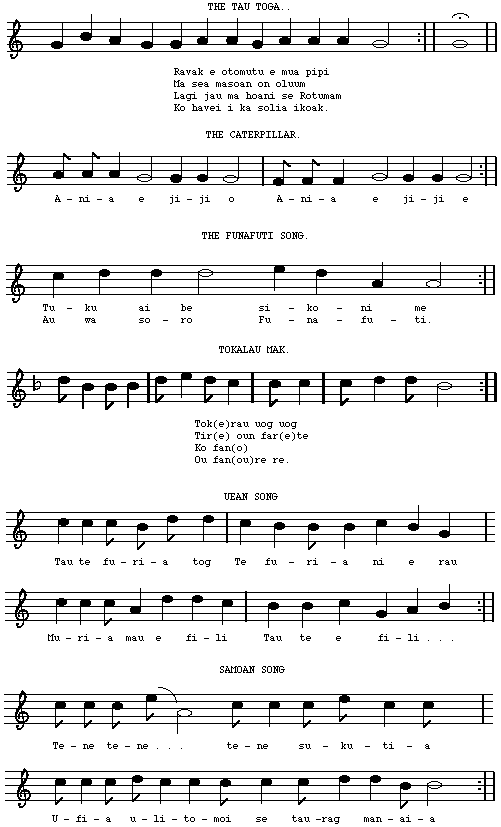From J. Stanley Gardiner (1898), "The Natives of Rotuma," Journal
of the Royal Anthropological Institute 27:488-491.
XXI. SINGING AND DANCING.
The island is curiously deficient in native songs and dances; the
people themselves speak of their songs and dances as furou or
foreign, except the class which are known under the name of tau
toga, the origin of which is quite unknown. The term mak is
applied to the combined song and dance. The meaning of the term tau
toga is obscure; tau seems to be
applied to a meeting of several, rarely a considerable number, of people
together, while toga, or tooga,
is quite unknown. The words of the songs are in an old language, which
is now practically forgotten, and cannot be translated even into modern
Rotuman by the natives themselves. Only a word here and there can be
recognised, and from these no sense could be gleaned. Probably the
meanings of many of the words have changed with the decadence of the
old language.
The tau toga may
be sung either on the feet or sitting, the time being always given
by beating on a folded-up mat with the hand. The song merely consists
of one verse, which is repeated generally three times if standing in
lines, the lines being changed thrice towards or at the end of the
verse. The mak is usually commenced on
the ground, when suddenly all rise and form quickly three rows, each
having three girls on one side and three men on the other, and all
facing in the same direction. At the end of the first singing of the
verse, the first row becomes the third row, and the second the first,
the singers crossing one another directly. The chief motions are made
with the hands pointed in different directions, while the feet are
firm, knees slightly bent and pointed outwards. At the end of the second
repetition, the original third row is in front. With the sudden call
of "Oh!" and three claps of the hands at the end of the third repetition,
all sit down with their backs towards the front. The time is as a rule
very slow; the lines often rhyme, and are in minor fifths. The mak always
ends with a long " Oh ! " three claps of the hands, and a low, deep,
drawn-out "Eh!"

A particular song, probably of modern growth, may be called the caterpillar,
as the motions are supposed to be representative of those of a caterpillar
as it crawls up the stem of the papoi,
straightening itself out, drawing its body up together, feeling for
a fresh hold, etc. There are generally three rows, as before, and all
move up the house or forward as they sing, nearly bent double.
Of mak forou, or foreign songs, there
are several which vary a great deal in the movements of the hands,
but as a rule are sung in much the same way as the tau
toga, when sung standing; the changing of the rows is managed
by the back row coming round the sides to the front, and not passing
each other in the middle. There are further movements of the feet from
side to side, and also of the body. The songs are shorter, and do not
necessarily rhyme; they are repeated perhaps two or three times before
the rows are changed. The time is given by striking a rolled-up mat,
or by the clapping of the hands or the stamping of the feet. Altogether
the mak forou are more lively than the tau
toga, and there is in them far more scope for movement.
Among the favourite mak forou is the
Funafuti song, supposed to have been introduced by a canoe from that
island driven on shore here; it is sung with much spirit and go. The
Tokalau mak, given, is a typical mak
forou. The next, "Tau te furia tog," is
a beach song; it is very rarely sung in the houses, as there is far
more dancing in it, movements up and down of the legs, clapping and
pointing of the hands, and contortions of the body. The time, too,
is much faster, and gets quicker at every repetition. I think that
it is not improbably an introduction from Uea or Wallis Island, as
it very greatly resembles several of their songs. The last song, "Tene,
tene," is a Samoan song; it is quite the pleasantest and least
harsh of all. The first line is repeated twice, and the whole or a
part of the second. It is usually sung in two lines with hands joined
facing one another; as they sing these lines dance in opposite directions
up and down in front of one another.
To Dr. E. A. Muller, of Sydney, who has heard
these songs on several occasions, I am indebted for the music. He has
also given me the following note:--All their songs move between one
octave and are sung in unison, except when both men and women are singing
together. Then the men sing in a lower pitch, about a minor fifth lower,
but do not follow the melody closely, so that they rather keep up an
accompanying noise in a lower note. Generally the change in rhythm
is very little in the different songs, mostly an andante movement,
while some songs, more indicating a humorous theme, are in allegro
style. The melody consists generally of three or four different notes,
the first one three or four times repeated, followed by a note a third
higher and going back to the first, again three notes followed by a
higher note or a lower one, finished always with an unharmonious flat
note."
|